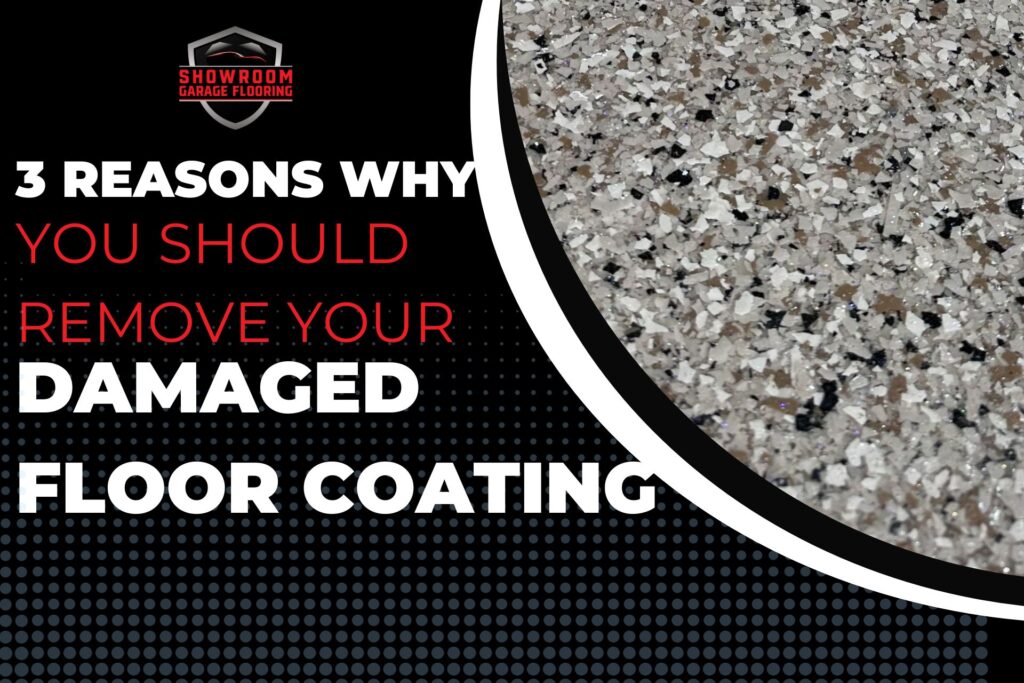Have you noticed wear-and-tear signs on your polyaspartic or epoxy garage floor? Whether it’s peeling or has damaged coating, these are signs that you need polyaspartic or epoxy floor refinishing. Depending on its physical condition, a simple recoating may resolve some issues. However, if the damage is too severe, flooring removal and resurfacing may be required.
Here are three signs it’s time to give your garage floor a refresh or a complete redo— and why you shouldn’t wait to fix minor damages.
When It’s Time for Polyaspartic or Epoxy Floor Refinishing
Homeowners commonly choose a polyaspartic or epoxy garage floor because of their easy maintenance. Both materials are simple to clean in comparison to concrete coating. They can last 10 to 20 years with routine upkeeping until recoating is required to maintain durability.
Below are three common types of polyaspartic and epoxy garage flooring damage and why it’s crucial to address them timely.
1. Aging Top Coating

As with any garage floor, wear and tear is inevitable from vehicle traffic and years of use. One of the first signs that it’s time to recoat your epoxy garage floor is when the top coating layer begins to age.
Common signs of aging top coating include:
- Peeling
- Flaking
- Chipping
- Small holes
- Scratches
If your floor’s top coating is aging, the good news is that it typically can be restored by professionals applying another layer so it looks brand new again. However, the longer you wait to fix these damages, the more deterioration can spread.
2. Improper Coating Installation
While it’s tempting and potentially cost-effective to make your own home improvements, you should never DIY coat your garage flooring. Recoating epoxy floors requires specific timing between coats to dry, and you may have waited too long or not enough. Additionally, you risk improperly mixing and installing the coating yourself. This can cause the epoxy or polyaspartic to cure before a proper chemical bond forms.
Some signs that your garage coating was improperly installed include bubbles in the finish, dim/less glossy surfaces, and separated concrete pieces. Remember, repainting an epoxy floor is simpler and cheaper with professionals than needing to remove and replace it due to a DIY misstep.
3. Peeling Coating or Delamination
If you notice your polyaspartic or epoxy garage floor coating is peeling or delaminating, you may have significant water damage in your home. Peeling coating and delamination are often caused if the environment is too humid or cold because these materials don’t bond to water well.
These conditions may be caused by downspouts and foundation/construction-based water issues on the concrete slab where the coating is applied. Some signs of concrete slab leaks found in your flooring are cloudiness, hardening, and improper curing.
Before recoating epoxy floors, you must address these potential structural problems before further property damage spreads that a refinishing cannot solve.
Additional Tips from Our Polyaspartic & Epoxy Garage Floor Experts
One of the biggest benefits of these materials is that once your new coating is applied, it can last up to 10 to 20 years. With ongoing polyaspartic and epoxy floor maintenance, you can preserve your garage flooring’s lifespan as long as possible.
Your Next Step to a Brand-New Epoxy or Polyaspartic Floor
The best investment you can make in your home’s polyaspartic or epoxy garage flooring is hiring professionals. At Showroom Garage Flooring, our team can help you determine which material is best for your flooring’s reapplication and fix existing damages. We even offer a 24-hour turnaround and a lifetime warranty for any brand-new flooring!
Ready to give your garage flooring the refresh it deserves?
Schedule a free consultation and on-site assessment today.

